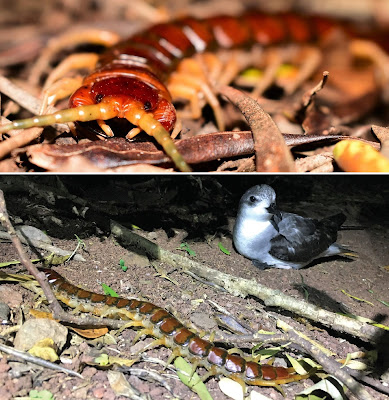 |
| Phillip Island centipede (Cormocephalus coynei; foreground (and upper)) with an adult black-winged petrel (Pterodroma nigripennis; background). Some foreshortening effect exists in this image, with the largest Phillip Island centipede measured at 23.5 cm (this study) and the combined head and body length of an adult black-winged petrel estimated at 28–30 cm (Marchant and Higgins 1990). Image by L. Halpin, 2018. in Halpin, Terrington, Jones, ... et Clarke, 2021. DOI: 10.1086/715702 |
Abstract
On isolated islands, large arthropods can play an important functional role in ecosystem dynamics. On the Norfolk Islands group, South Pacific, we monitored the diet and foraging activity of an endemic chilopod, the Phillip Island centipede (Cormocephalus coynei), and used a stable isotope mixing model to estimate dietary proportions. Phillip Island centipede diet is represented by vertebrate animals (48%) and invertebrates (52%), with 30.5% consisting of squamates, including the Lord Howe Island skink (Oligosoma lichenigera) and Günther’s island gecko (Christinus guentheri); 7.9% consisting of black-winged petrel (Pterodroma nigripennis) nestlings; and 9.6% consisting of marine fishes scavenged from regurgitated seabird meals. Centipede predation was the principal source of petrel nestling mortality, with annual rates of predation varying between 11.1% and 19.6% of nestlings. This means that 2,109–3,724 black-winged petrel nestlings may be predated by centipedes annually. Petrels produce a single offspring per year; therefore, predation of nestlings by centipedes represents total breeding failure for a pair in a given year. Our work demonstrates that arthropods can play a leading role in influencing vertebrate reproductive output and modifying trophic structures and nutrient flow in island ecosystems.
 |
| The Phillip Island centipede (Cormocephalus coynei) has a diet consisting of an unusually large proportion of vertebrate animals, including seabird chicks. photo: Daniel Terrington |
 |
| Black-winged petrel chick just prior to being weighed on Phillip Island. photo: Trudy Chatwin |
Luke R. Halpin, Daniel I. Terrington, Holly P. Jones, Rowan Mott, Wei Wen Wong, David C. Dow, Nicholas Carlile, and Rohan H. Clarke. 2021. Arthropod Predation of Vertebrates Structures Trophic Dynamics in Island Ecosystems. The American Naturalist. DOI: 10.1086/715702
La depredación de artrópodos sobre vertebrados estructura las dinámicas tróficas de ecosistemas insulares
En islas remotas, los artrópodos de gran tamaño pueden jugar un papel funcional importante en la dinámica del ecosistema. En las Islas Norfolk, en el Pacífico sur, monitoreamos la dieta y comportamiento de forrajeo de un quilópodo endémico, el ciempiés de Phillip Island (Cormocephalus coynei), y usamos isótopos estables para estimar la composición de su dieta. La dieta del ciempiés de Phillip Island está representada por animales vertebrados (48%), e invertebrados (52%): con un 30.5%, las especies del orden Squamata como el eslizón de Lord Howe Island (Oligosoma lichenigera) o el gecko de Günther’s Island (Christinus guentheri); un 7.9% pollos de petrel alinegro (Pterodroma nigripennis); y un 9.6% peces obtenidos de los regurgitados de las aves marinas. La depredación por parte de los ciempiés fue la principal causa de mortalidad de los pollos de aves marinas, con tasas de depredación entre el 11.1% y el 19.6%. Considerando el límite superior del tamaño poblacional estimado para el petrel alinegro, los ciempiés podrían estar depredando 2.109–3.724 pollos por año en este ecosistema. Como los petreles producen un solo huevo por año, la depredación del pollo representa el fracaso reproductivo total para una pareja en ese año. Nuestra investigación demuestra que los artrópodos pueden desempeñar un papel central en los ecosistemas insulares, al influir en el éxito reproductivo de vertebrados y modificar las estructuras tróficas y el flujo de nutrientes.
Giant bird-eating centipedes exist—and they're surprisingly important for their ecosystem

